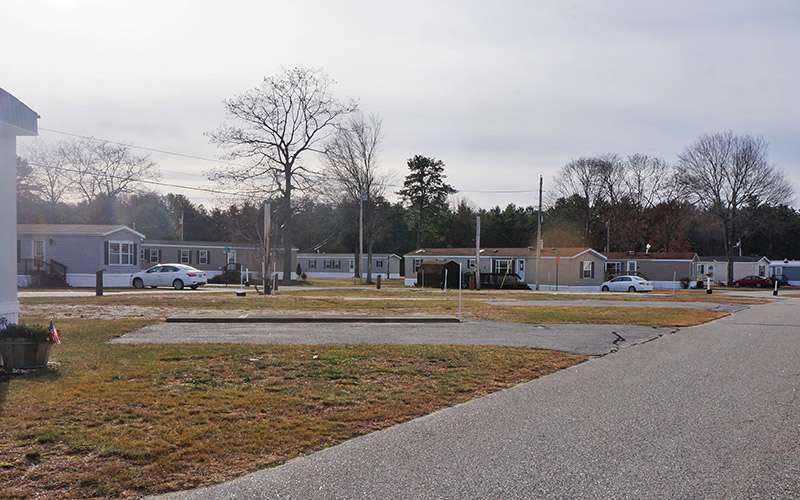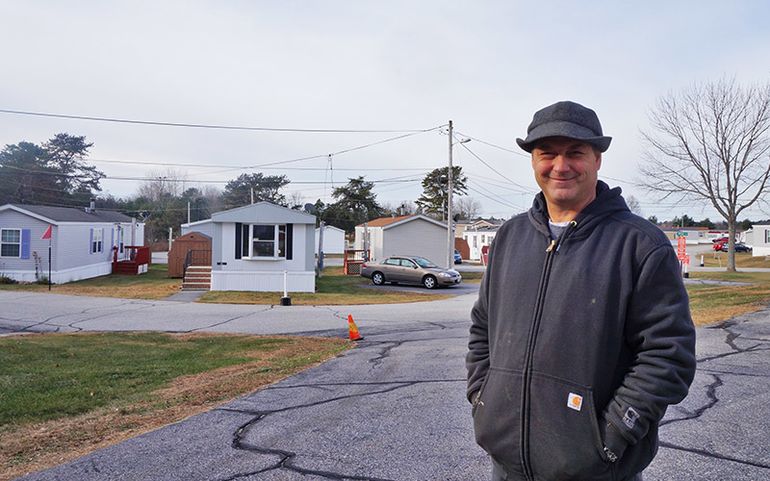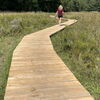
Mobile home park owner hopes tiny homes will be a win-win
 Photo / Maureen Milliken
Kitt Scarponi, of Linnhaven Mobile Home Center in Brunswick, would like to allow tiny homes, but building regulations make it difficult.
Photo / Maureen Milliken
Kitt Scarponi, of Linnhaven Mobile Home Center in Brunswick, would like to allow tiny homes, but building regulations make it difficult.
BRUNSWICK — When a tiny home owner asked Kitt Scarponi if he could move his house to Linnhaven Mobile Home Center, the general manager of the 300-unit community saw an opportunity for both homeowners and the mobile home park.
When the mobile home center opened in 1954, mobile homes were smaller, and tiny homes would be a good fit for vacant smaller lots. Allowing them at the 50-acre community would also help people who were looking for harder-to-find affordable space.
He envisioned a cluster of vacant lots that are too small for today’s mobile home becoming Tinyville, a tiny home community amid the bigger mobile homes.
But more than a year after the first tiny home landed at Linnhaven, it’s still the only one there as the reality of the homes clashes with the reality of building ordinances.
The state enacted regulations for homes smaller than 400 square feet in January, which basically treat them as much smaller traditionally built homes.
Brunswick Code Enforcement Officer Jeff Hutchinson said in Brunswick, “They would be considered to be small stick-built [non-prefabricated] homes and allowed in Brunswick where stick-built homes are permitted.”
Hutchinson said that if the smaller homes can be built to the State Model Building Code, state plumbing and electrical codes and the town’s housing codes, and are inspected during the construction process by the town’s code enforcement department, they are fine.
But many tiny homes don't meet the criteria, and where to locate is an ongoing issue in Maine. Many tiny home advocates suggest locating in smaller towns, where zoning ordinances and other rules may not be as strict.
Scarponi agreed, saying towns are trying to find ways to fit them into current building codes, or looking for a definitive standard.
He said, though, a different approach might work — having HUD embrace tiny homes the way it did mobile homes in the 1970s. Those federal standards preempt state and town standards, and towns can’t require a building permit for a HUD mobile home or enact standards that conflict with HUD’s.
Differences with state and town standards can include utility requirements, egress requirements, minimum floor size and more.
“Today’s tiny home is a HUD mobile home,” he said.
'Focus on enjoying life'
Mobile homes became a residential reality rather than just a travel option after World War II, when veterans returned from war to a housing shortage.
The post-war prefabricated house that is known as a “mobile home” was invented by James Sweet of Mobile, Ala., in the late 1940s, and “mobile home” first referred to the city where they were built, not the fact the buildings can be moved.
The industry took off once the residences could be easily transported on the country’s highway system, which was built in the 1950s and 1960s.
Linnhaven, which opened in 1954 as one of Maine’s first mobile home parks, was part of that boom.
In 1976, Congress — reacting to resistant zoning and other issues with local ordinances, and in the interest of making more safe and affordable housing available — set standards for construction.
In Maine, 8.9% of the state’s housing units are mobile homes, and they house 11% of the state’s population, according to statemaster.com, which tracks housing statistics, and the 2010 U.S. Census.
Scarponi said while there’s sometimes a stigma around mobile home living, “Mobile homes are like people, the only thing that matters is what’s inside.”
“When I show a home, people will tell me, ‘This is kinda small, I can't get all my stuff in here.’ That’s when I say, ‘That’s the beauty of successful mobile home living, it forces you to get rid of all your unnecessary items and focus on enjoying your life. When you get rid of all the junk in your life you'll feel 10 pounds lighter and happier and have more time to do the things you want to do.”
He added: “You’ll be surprised how often people embrace that idea.” Many of the residents at Linnhaven are young families just starting out, or boomers who are downsizing.
Mobile homes and tiny homes are basically the same thing, he said.
He also sees a need for housing and a way to solve it, and has empty plots at Linnhaven that could accommodate tiny homes.
He’s not alone — a few months ago the Presque Isle planning board approved a proposal for 23 tiny home lots at a mobile home park left largely vacant after Loring Air Force Base shut down.
Making it work

Things slowed down at Linnhaven after the Brunswick Naval Air Station closed in 2011.
“With the base closing, we took a hit,” Scarponi said.
But things have picked up in the last year. Part of it is that Brunswick Landing, on the former air base campus, will have added 2,000 jobs by the end of the year, with more coming.
But there’s a housing crunch and a lot of people in southern Maine are priced out. Mobile homes, and tiny homes, are a good solution, Scarponi said. They are cheaper than other housing, and can be moved to a lot.
“It’s almost like things have come full circle [from the mobile home boom],” he said.
Scarponi was happy to work with the owner of the tiny home who approached him a year and a half ago. [He has asked that the homeowner’s privacy be protected, including not using photos of the home.]
He said one issue was the home’s utilities — HUD regulations require mobile home utilities to be nestled under the structure to protect them from the elements. The tiny home’s are on the side, and they had to find ways to winterize them.
The home stands out among the long, neat rows or mobile homes on the well-manicured property.
It’s fairy-tale cute, with forest-green siding, and a wood front with hanging plants. It has broad wooden front steps and a skirt around the bottom just like the other homes that surround it.
The setting is nice, too — the home is at the end of a line, and borders on the fields of a nature preserve. It's on a narrow lot, next to a much larger mobile home.
Small homes for small lots
With about 600 residents, Linnhaven is larger than about 20% of the state’s 455 municipalities.
Scarponi and his brother, Kurt, grew up at Linnhaven, which has been in their family for decades, and they now run it. There are five employees, including the two brothers, and they do all the maintenance, plowing, and whatever else needs to be done.
“We’re a mom-and-pop park, and we want a quality residential base,” he said. “We keep it quiet, clean and affordable. We’re always here, all the time.”
He said there are residents who have lived at Linnhaven for 50 years, and there are some vintage mobile homes, too.
Homes still on old sites have been grandfathered, but as mobile homes have gotten bigger, they can no longer go on the smaller sites, so there are some vacant spots, including the cluster at the potential Tinyville.
If more tiny homes could locate at Linnhaven, it would be a win for both owners looking for places for their home, and for Scarponi’s empty lots.
He said Linnhaven is willing to work with an owner to help a tiny home conform to the town’s building laws.
He's also keeping his fingers crossed as the homes become more popular, that finding places for them will become easier, just the way it did with mobile homes 60 or 70 years ago.
“After all, tiny homes are just mobile homes, only tinier,” he said.










Comments